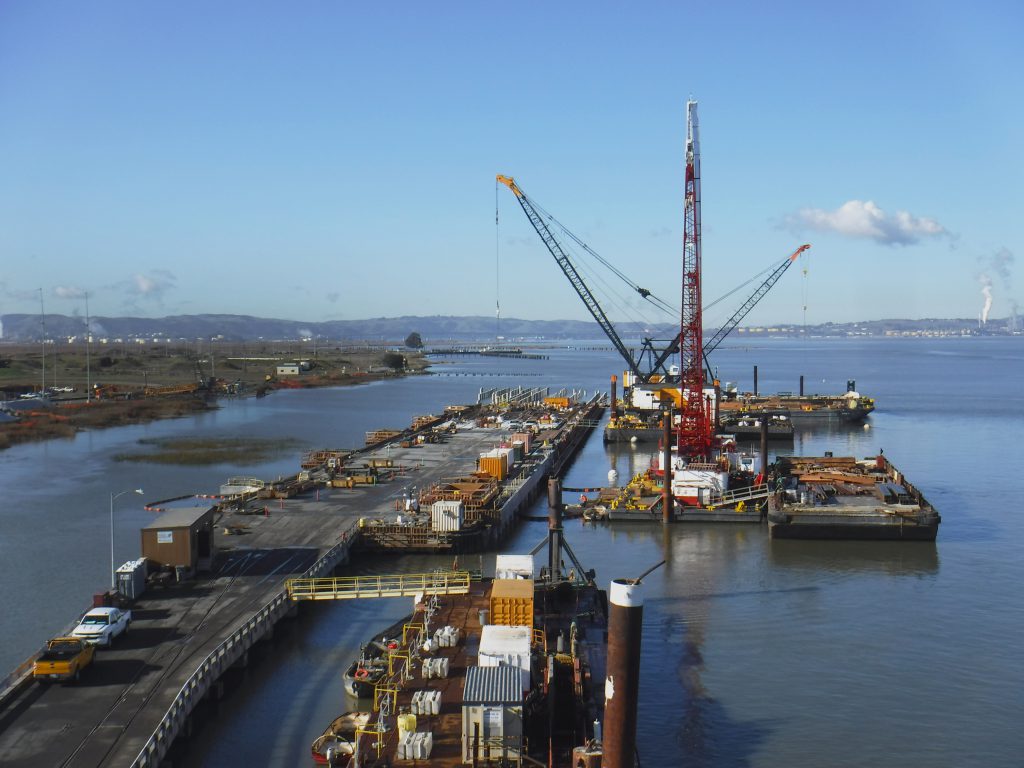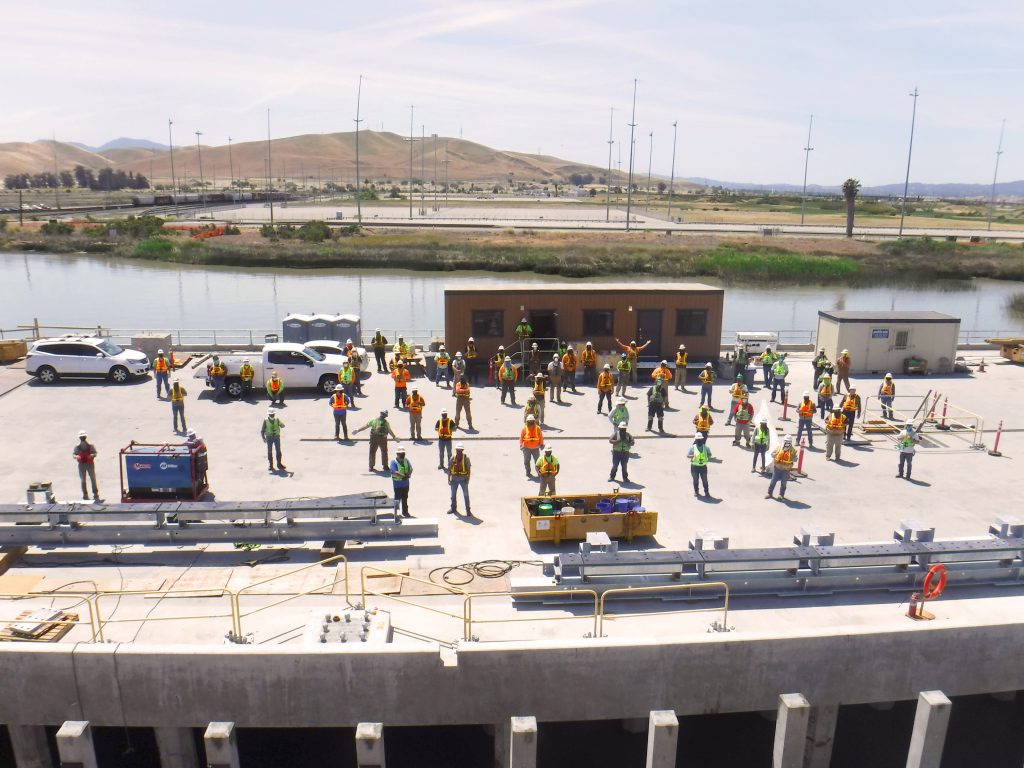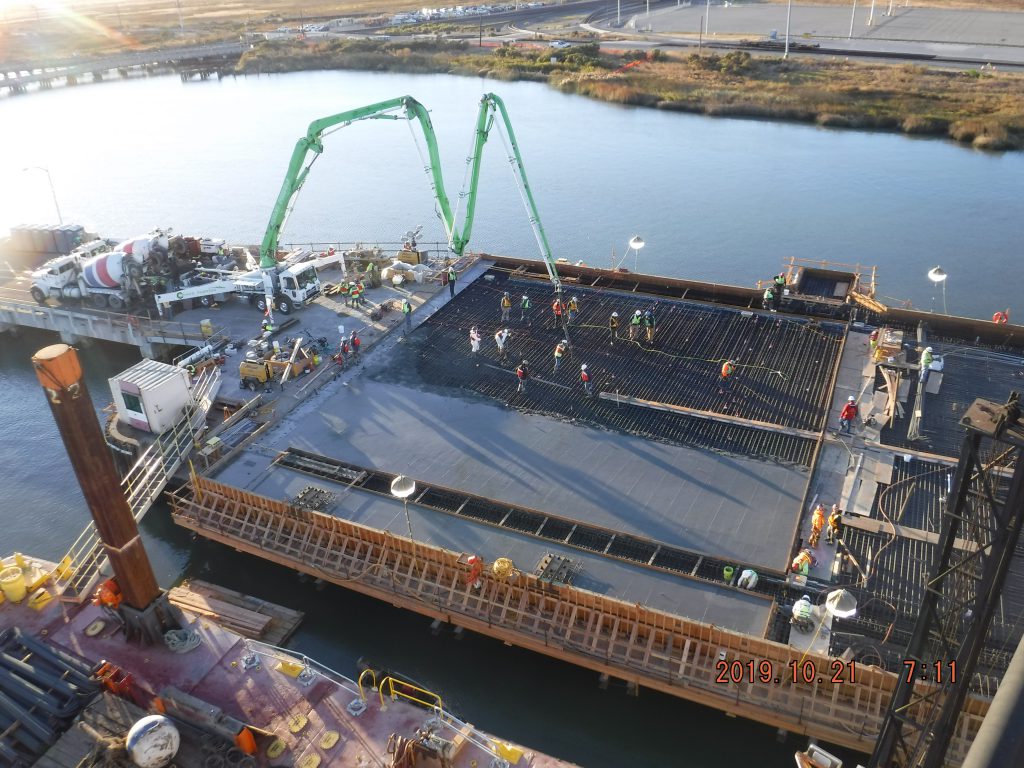For the historic military installation at MOTCO that serves the Indo-Pacific Command, Kiewit/Manson has rebuilt a critical piece of infrastructure.
It’s not often your work is on the weekly discussion docket at the Pentagon. For the 22 staff and 90 craft charged with rebuilding Pier 2 at the Military Ocean Terminal in Concord, California (MOTCO), that’s been a point of pride.
The Sacramento district of the U.S. Army Corps of Engineers (USACE), the project client, says the job is one of its most important national defense projects.
Located 30 miles east of San Francisco in Suisun Bay, MOTCO is one of only two ship-loading and offloading complexes in the country, and the only one on the West Coast that handles munitions for overseas military operations.
Built as a U.S. Navy facility during World War II, today the site provides ammunition and related supplies for Department of Defense operations in the Indo-Pacific Command.

Increasing MOTCO capabilities
While the previous Pier 2 had undergone improvements in the 1970s, it was time for an upgrade to make operations more efficient.
The USACE is overseeing close to $350 million of construction at MOTCO as part of a base modernization program. Projects include upgrades to waterfront infrastructure, such as the Pier 2 rebuild, road and railway improvements, access control points, bridge repairs, and upgrades to utility infrastructure.
In December 2018, joint venture Kiewit/Manson began work on demolishing the old 159,000-square-foot timber structure, including removing 4,500 creosote-treated timber piles and 254 concrete square piles, in order to make way for the new all-concrete Pier 2.
Construction on the new pier required driving 793 new 24-inch octagonal pre-stressed concrete piles made by Kiewit subsidiary Kie-Con Inc., 134 square concrete piles, 11,000 cubic yards of concrete, and 3,300 tons of reinforcing steel.
By implementing a design that centrally locates operations on the base, Kiewit/Manson’s work on Pier 2 will increase MOTCO’s capabilities by about 25 percent.

Getting craft vetted
One of the early challenges was the coordination required to get the materials, suppliers and subcontractors approved by the military, said Keith Boulton, who served as general superintendent and later as project manager.
“It’s not like you can call the union hall on a Friday and say ‘I need a carpenter on Monday’ — you just can’t do that.”
Before an applicant could come on base, a stringent vetting process required gathering all the applicant’s background information, submitting it and getting approval to begin work.
“Kiewit/Manson was very good about getting all the documentation in early, asking questions, pushing things through on off-peak times,” said Capt. Josh Olson, who was USACE project manager through June 2020.
“When it came to peak construction, everybody was set and there were minimal issues getting access on and off base.”
Creating optimum traffic flow
The team also had to perform some deft footwork to make sure traffic moved smoothly on the limited number of roads in and out of the base. That meant sharing the road with other contractors as well as the nearby MOTCO crews. “We were working five hundred feet away from the pier where they’re loading and unloading all these munitions,” said Matt DiCrescentis, project manager.
A big challenge was how to partner with the Corps and MOTCO to make sure the team didn’t impede MOTCO operations while also limiting impacts to Kiewit/Manson’s construction execution.
“It was just coordination, coordination, coordination,” DiCrescentis said.
Kiewit/Manson helped deconflict the two by creating an additional pattern of traffic flow, with construction traffic going one way and operational traffic going the other.
“That was a huge deal from an operational standpoint to keep as many roads open so we had the least amount of impact possible,” said Capt. Olson. “Kiewit/Manson was very good about working with the installation and USACE in deconflicting those traffic routes.”

A linear pier pour
More challenges were facing the team: How to install a 300-foot-long permanent approach trestle in shallow water without constructing a temporary standalone trestle, and doing the additional preconstruction concrete testing to achieve a minimum 50-year design life for the new pier.
Because the job permit didn’t allow a temporary trestle to be built next to the pier in this environmentally sensitive area, Kiewit/Manson had to think creatively.
With an assist from Kiewit Engineering Group Inc., they came up with a solution to build the new deck and west trestle using a linear, schedule-driven model, said Joe Eiras, structures superintendent.
The crew drove the permanent piles and built a temporary trestle on the piles from the shore to where the trestle met the pier.
Coming back, they pulled two or three spans of the temporary structure at a time, then poured the concrete caps and set the precast concrete slab beams for the permanent structures.
Eiras noted the lack of drama on the project. “Uneventful is a good thing in construction a lot of times. I’m really proud of the crew that built it and really happy with how it turned out.”
‘A beautiful pier’
Achieving the necessary concrete strength with other critical concrete characteristics was also integral to the project’s success, Boulton said.
“The concrete strength was a very specific requirement where they wanted a maximum strength and a minimum strength. So the supplier had a small window — between 5,000 and 6,200 psi at 28 days — where we had to hit those strengths.”
One of the biggest accomplishments on the job, Boulton said, was placing 11,000 cubic yards of concrete to stringent specifications.
The team has many reasons to be proud of the finished product, from how it looks to how the crew performed.
“It’s a beautiful pier,” Capt. Olson commented. “The team did really, really great work from an aesthetic and structural standpoint. They were always willing to do whatever they could to keep the project moving forward and deliver on promises made.”


